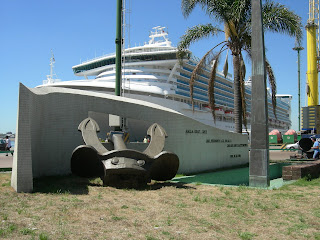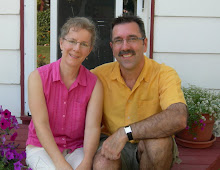
In the central region of Chile, cowboys are known as "Huasos" and are known more for their fine horsemanship and rodeo work. Their traditional wide brimmed hat is more for sun than rain. Also notice the large spurs, stirrups, and high leather leggings for protection in the rodeo ring.
You may recall us talking about the national dance of Chile, the Cueca, where the Huasos are an integral part.

Well . . . I didn't intend this to be a lesson on cowboys so . . . what did we see and do in Uruguay?!

Have you ever found that when you visit a place, you almost immediately get a feel for whether you'll like it or not? Our feeling in Montevideo was a good one. Once again, I'll start with some information from the literature that was supplied to us by the cruise line.
"Nestled between Brazil and Argentina, Uruguay is the second smallest country in South America. (Suriname is the smallest! That's a trivia question that you can stump your friends with!) More than half of the nation's population of 3 million live in the capital of Montevideo (Monte-vi-day'-o), located at Uruguay's southernmost point on the Rio de le Plata (river of silver). The only prominent natural feature seen from the sea is a cerro, a 150 meter hill. The hill is reputed to have given Montevideo its name when a Portuguese sailor called out on first sighting it, "Monte vejo eu" (I see a mountain).
The 1.8 million residents of Montevideo are primarily of Spanish and Italian extraction, and the atmosphere of the city is unlike that of many other South American capitals. Uruguayans have a great deal of civic pride, and although a few slums have appeared, they have not surrounded the city as has happened in so many other places. Streets are well tended, parks are landscaped and well maintained, and the city has a tidy look to it. Part of the city's neat appearance is due to the country's social system. Uruguay has often been called the "Switzerland of South America", primarily because of its small size (the smallest Hispanic nation in South America, about the size of England and Wales), its once high standard of living, and its extraordinary democratic institutions. The 1918 constitution laid the foundation for social programs that are unparalleled anywhere on the continent today. At the time, these programs were more advanced than anywhere else in the Western Hemisphere: an 8 hour work day, paid holidays, social security for the aged, free medical treatment, legal divorce, nationalization of almost all essential industries, abolishment of capital punishment, separation of church and state and so on."
After leaving the ship we immediately came upon a little outdoor museum. That is the Star Princess in the background with the flag of Uruguay in the foreground.

The anchor in the foreground is from a German ship called the "Admiral Graf Spee". It was recovered in 2004 and has an interesting story attached to it. In 1939 , the state of the art German battleship was in the South Atlantic to disrupt the supply line to Europe when it came across two enemy destroyers. A battle ensued, and when the Graf Spee was heavily damaged, it retreated to the nearest port, Montevideo. Uruguay at the time was neutral and as a result, gave the captain 72 hours to make repairs and leave. In the meantime, the British circulated reports on shore that several battleships had gathered nearby and were waiting for the German ship's departure. Realizing that he was badly damaged, and believing that he was out numbered and out gunned, Captain Langsdorff, left the harbour and scuttled the ship. The Graf Spee is credited (blamed) for sinking several merchant ships, but the captain strictly adhered to the rules of mercantile warfare at the time and saved all of the crew members of these ships; not a life was lost in these sinkings.

This is a "Range Finder" that has been recovered from the ship. It was the first radar system ever mounted on a battleship and was designed to make cannon fire more accurate.

We suspect that this is some sort of tourist train but we aren't sure.

While the train is very nice (and in working order), the big picture here is just how nicely the port area is kept. When a port looks this good, it's a pretty good indication of how the rest of the city might present itself. Montevideo is indeed a lovely, clean city.

Here we are . . . half way though the blog and just leaving the terminal!! We didn't book an organized tour here so we were left to explore on our own.

The following photo shows what remains of the Spanish Wall. It provides the entrance to the city's main plaza, Independencia.


It is in the plaza that Uruguay's hero sits on horseback. Jose Gervasio Artigas is considered to be the country's Father of Independence, and his remains are located within the statue. Uruguay gained it's independence from Spain in 1827.

This former palace borders the plaza and is now either a hotel or apartments (we couldn't get a definitive answer).

Also on the plaza is Government House.

South Americans seem to have a great deal of pride in their history, and particularly, military history. Many of the buildings and major thoroughfares are named after military heroes and their associated battles. This is Avenida Libertador Lavalleja, named after one of the country's liberators, Juan Antonio Lavalleja. We took a cab up this avenue to get to . . .

the Legislative Palace, which sits at the head of the avenue.

This is the other side of, in Saskatchewan language, "The Leg".

We aren't sure what this building is. It was just across the street from the Legislative Palace and is an example of the interesting buildings that are very common here.

For some unknown reason, I didn't take many pictures here, so we will have to relate the rest of the story with words only!
While in a craft market and talking to a vendor with perfect English, we decided that we would take another cab ride to a different part of the city, for two reasons . . . lunch and a sightseeing adventure (not to mention that the vendor in the market told us the drive along the coast line was "beautiful" and that there were excellent restaurants in that particular part of town). The cab ride took us along the sea shore drive known as the Rambla for about 40 minutes. On one side were about a bazillion apartment buildings and on the other, endless, but somewhat polluted, beaches.
Part of what made this particular adventure interesting was that upon reaching our destination, the cab driver wouldn't take American cash, and we didn't have any local currency. We just happened to stop in front of a bank, but after that was taking too long, the driver took us across the street to a restaurant that would change our money if we ate there! Hmmm. Of course, there was a lot of conversation in Spanish going on between the cab driver and the maitre'd.
The maitre d' changed our money but at a very favourable rate . . . for himself! After some protest, he improved his offer. Keep in mind that NONE of this was was happening in English, and as much as we wanted to believe that the cab driver was just trying to be helpful, we weren't really sure exactly what was going on, and that was making me very cranky! (Were we getting ripped off??!!) While we were talking about money issues, we were strongly encouraged to have a seat, and before we knew it, there was a flurry of activity around us.....a bread basket was produced, menus, cutlery, etc. We did end up eating at that restaurant (mostly because we were very hot, thirsty, hungry and too exhausted to go and find another place) and the meal was . . . OK. The other element to the story was whether or not we could make our way back to the ship before it left for Buenos Aires! During lunch we didn't see many cabs, but once it was time to leave, it didn't take long to find a ride. This time, we made sure that currency would not be an issue!
We did arrive back at the port with a few minutes to spare, and we used that time in a nearby cyber cafe to fire off a few quick emails.
This will be be our last night on board as tomorrow will bring disembarkation (yes, apparently, that is really a word) in Buenos Aires, our final stop. It's the shortest leg of the trip at 138 nautical miles inland via the Rio de le Plata, and the captain says that our bags must be packed and outside of our cabin by 8:00 tonight so "a packin' we will go"!
Hasta Luego,
Amor,
Norm y Charlene
